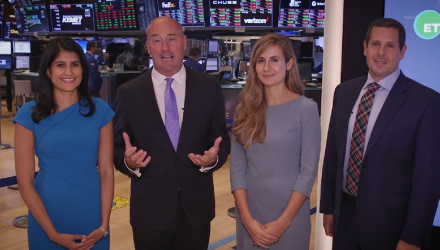“Trade wars and a strengthening dollar have caused havoc in international markets this year,” said Azzarello. “I think short-term it’s actually a buying opportunity because we still believe in the longer-term story. They key is you want to dampen volatility in the international markets and you want to hold them.”
Before an investor looks to deep dive into the EM space, he or she must be still selective and exercise due diligence. Simply selecting a country-specific ETF in emerging markets without the proper research could be akin to catching a falling knife so investors must approach EM with caution.
“It’s still an attractive place to be,” said Dahya. “It’s still a good source of diversification in your equity bucket. Valuations are still attractive. I would argue that similar to the U.S., maybe try something non-market cap weighted, something that is a little more balanced, something that can weather that volatility.”
Dahya references the JPMorgan Diversified Return International Equity ETF (NYSEArca: JPIN), which has been a success story for the firm since it has been able to demonstrate downside capture. JPIN seeks investment results that closely correspond to the performance of the JP Morgan Diversified Factor International Equity Index, which is comprised of equity securities across developed global markets (excluding North America) selected to represent a diversified set of factor characteristics: value, price momentum and quality.
Opt for Short Duration in Fixed Income
The month of September saw a hawkish Federal Reserve raise the federal funds rate another 25 basis points with hints that a fourth and final rate hike to cap off 2018 is likely given a tailwind of more positive economic data. This has presented challenges for fixed-income investors who are also seeing rising yields in benchmark Treasury notes.
“Fixed income is a very hard place for investors right now because of this fear they have of rising rates,” said Dahya. “I want investors to know there are solutions for you to help get the most out of your fixed income allocations.”
According to Dahya, one area where investors can seek opportunities is shorter duration strategies to limit prolonged exposure to the bond markets. This addresses two main fear factors in the fixed income markets—rising interest rates and a flattening yield curve.
“What investors are looking for is strategies that can help protect against rising rates, but still preserve their yield,” said Dahya.
Dahya mentioned JP Morgan’s strategy of giving investors broad market exposure to bonds via the Bloomberg Barclays U.S. Aggregate Bond Index (Barclays AGG), but with shorter duration. In fact, Dahya mentioned that the firm’s strategies have provided investors with 80% of the yield from the Barclays AGG, but with 8% of the duration—a value proposition worth considering in the bond markets.
Use ETF Adaptability to Your Advantage
Because of their adaptability as an investment product, ETFs have experienced exponential growth with respect to capital flows. With over $120 billion in assets coming in domestically, that growth is expected to only continue as more ETFs enter the marketplace.
The proliferation of ETFs has allowed them to corner specific areas around the globe like emerging markets, and while EM was decimated in 2018, Yones is still seeing an influx of capital. The investor behavior speaks to the popularity of ETFs and investors willing to flock towards these products despite the underlying economic conditions in these areas of investment.
Whether an ETF is being used as a short-term tool for lightning-quick plays by day traders or as value plays by buy-and-hold strategists, the adaptability of the product is readily apparent.
“It says people are still leaving traditional investment funds and buying ETFs regardless of market conditions,” said Yones. “They’re using them not to just say, ‘Hey, short-term, here’s my strategy,’ they’re using them for long-term core holdings and it shows the growth of the ETF investment across everyone’s portfolio.”
Embrace Change
With ETFs growing at a rampant pace, innovation has been a byproduct and companies are finding new ways to accommodate the growth in this space. However, this accelerated growth means that more regulation may be necessary to maintain the ETF industry’s attribute of transparency.
New rules are in the making by the Securities and Exchange Commission (SEC), which will allow for easier, more accessible ETF creation. Rule 6c-11, known throughout the industry as “The ETF Rule,” would permit prospective ETF issuers to organize and operate without the expense or delay associated with obtaining an exemptive order from the SEC.
“This proposal would basically streamline launching ETFs,” said Yones. “If you’re an asset manager, or say even a small manager of funds for your portfolios of clients, but yet you think, ‘Hey, I can make some efficiency here by putting it in an ETF wrapper,’ today that could cost a lot of money.”
With the new SEC law, ETF creators can bypass much of the bureaucratic red tape by following a proposed set of rules without the typical costs associated with a fund’s creation. According to Yones, this would allow for lesser fees to the investor, more product offerings and tax advantages.
To watch the entire set of “In the Know” segments, click here.
